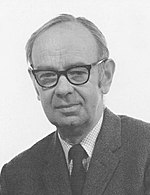Alan Robertson (geneticist)
| Alan Robertson | |
|---|---|

Alan Robertson
|
|
| Born |
February 21, 1920 Preston |
| Died | April 25, 1989 (aged 69) |
| Nationality | England |
| Fields | Population genetics |
| Institutions | University of Edinburgh |
| Alma mater | University of Cambridge |
| Notable awards | |
Alan Robertson FRS (21 February 1920 – 25 April 1989) was an English population geneticist. Originally a chemist, he was recruited after the Second World War to work on animal genetics on behalf of the British government, and continued in this sphere until his retirement in 1985. He was a major influence in the widespread adoption of artificial insemination of cattle.
In addition to his work on agricultural genetics, Robertson undertook extensive studies of other branches of genetics, developing an influential secondary theorem of natural selection. He acquired an international reputation, receiving state and academic honours from Europe, America and Asia.
Robertson was born in Preston, Lancashire, the second and only surviving child of John Mouat Robertson, an employee of the Post Office, and his wife Annie, née Grace, who was the younger sister of the University of Cambridge mathematician John Hilton Grace. Annie Robertson died within days of giving birth to her second child, who was brought up by his aunt Bessie Grace on the family farm at Halewood, near Liverpool. He was educated at Halewood village school from where he won a scholarship to the Liverpool Institute High School in 1930. He distinguished himself there in languages and in science under the tutelage of the chemistry master L. A. Naylor. In 1938 he won a scholarship to Caius College, Cambridge to read chemistry. He graduated in 1941 with an upper second class degree, and became a research student in the Department of Colloidal Science at Cambridge.
During the Second World War Robertson served in the Operational Research Section of Coastal Command. The head of the unit was Conrad Hal Waddington, who after the war invited Robertson to join him in a new research body, the National Animal Breeding and Genetics Research Organisation (NABGRO). In an obituary study of Robertson, W. G. Hill wrote, "At this stage Alan could have had no more than a passing acquaintance with genetics, but he did have a firm understanding of practical farming. … Waddington wanted to apply operational research methods to animal breeding and recognized Alan's mathematical talents and ability in operational research."
...
Wikipedia
